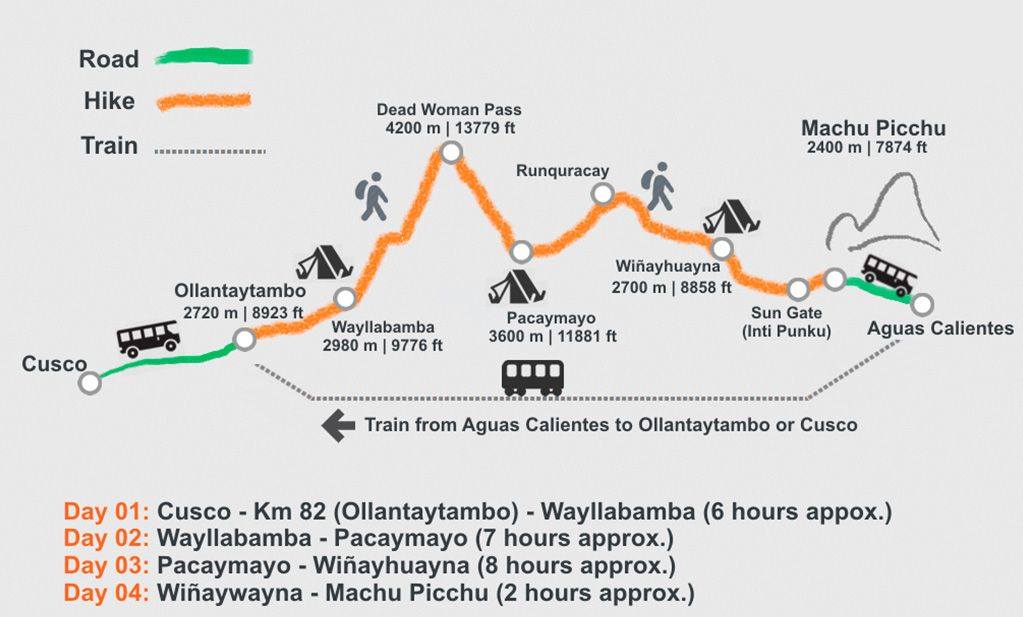The best-known tourist section of the Inka road system is the one that leads to the citadel of Machu Picchu: The Inka Trail to Machu Picchu.
The route usually starts from the town of Qoriwayrachina, an old town whose ruins are found in the district of Vilcabamba. The route covers a distance of approximately 45 km and takes four days and three nights to follow.
The second day of the trek is the most intense, because it crosses Warmihuañusca, a valley located at 4,200 meters above sea level. That is the highest part and the one that demands the greatest physical demand.
There are also other routes with which it is possible to shorten distances and reach the famous citadel in two or three days.
The natural setting is impressive: a landscape full of tropical forests, desert cliffs and imposing snow-capped peaks such as Salkantay or Humantay, more than six thousand meters high, extensive grandstands worked on the rocks, tunnels up to twenty meters long and several complexes archaeological sites, among which Intipata, Runkuraqay and Intipunku stand out.
If you want to live the experience and admire in greater detail the natural environment of the Inca Trail to Machu Picchu, the authorized camps are Patallacta, Huayllabamba, Llulluchapampa, Pacamayo and Wiñayayna. Except between December and March, months in which it rains copiously, any time is opportune to travel the Inca roads.
The Inka Trail to Machu Picchu Map

Short Inka Trail 2 Days
A guided trek with stops at the highlights along the way. It consists of a steep ascent of three to four hours from kilometer 104 to Wiñaywayna and then another two hours on more or less flat terrain to Machu Picchu.
You spend the night in Aguas Calientes and visit Machu Picchu the next day.
Inka Trail 4 Days
The 4-day Classic Inca Trail is a hiking route that runs through part of the ‘Qhapac Ñan’, the ancient Inca roads that the Incas built. A part of this route was the one that connected Cusco with Machu Picchu.
Which is The Best Moment for Hiking the Inca Trail?
It is important to choose the best time. Groups are organized throughout the year (except in February, when it rains heavily and the Inca Trail is closed for maintenance), but the best months (coldest and driest) are June, July and August.
The problem: they are also the most demanded. To avoid crowds, it is best to go before or after the rainy season (March to May) or from September to November.
Booking The Inca Trail in Advance:
As in many other hiking trails with high demand around the planet, it is necessary to make a prior reservation for the Inca Trail.
We highly recommend to book six months in advance if you want to travel it on dates outside of high season, and from eight months to a year if you want to do it from May to the beginning of September.
The two-day route is also usually as crowded as the 4 day trek and bookings are done. Only authorized operators obtain permits.
It is best to agree on a five-day trip, which will allow us to walk more relaxed and enjoy the landscape, as well as find less crowded camping places. It is also important to take out travel insurance that covers outdoor activities.
What to Pack for The Inka Trail to Machu Picchu
It is advisable to bring walking sticks, a small first aid kit, sunscreen, sandals or crocs for the camp, jacket, raincoat, hat and gloves, sun hat, travel towel, hiking boots , thick socks, thermal underwear, fleece, a bottle or hydration pack, mosquito repellent, long pants, and sunglasses.
